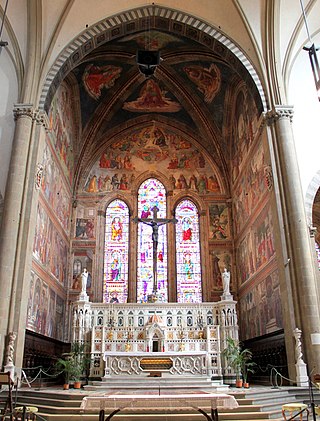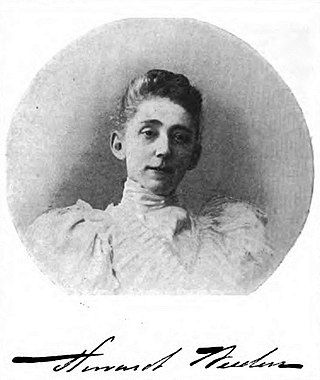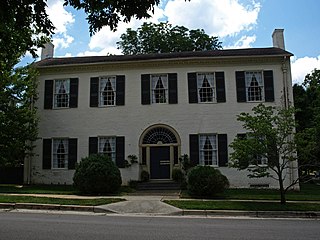
Michelangelo Merisi da Caravaggio, known mononymously as Caravaggio, was an Italian painter active in Rome for most of his artistic life. During the final four years of his life, he moved between Naples, Malta, and Sicily until his death. His paintings have been characterized by art critics as combining a realistic observation of the human state, both physical and emotional, with a dramatic use of lighting, which had a formative influence on Baroque painting.

Huntsville is the most populous city in the U.S. state of Alabama. It is the county seat of Madison County with portions extending into Limestone County and Morgan County. It is located in the Appalachian region of northern Alabama.
Primitive Baptists – also known as Regular Baptists, Old School Baptists, Foot Washing Baptists, or, derisively, Hard Shell Baptists – are conservative Baptists adhering to a degree of Calvinist beliefs who coalesced out of the controversy among Baptists in the early 19th century over the appropriateness of mission boards, tract societies, and temperance societies. Primitive Baptists are a subset of the Calvinistic Baptist tradition. The adjective "primitive" in the name is used in the sense of "original".
Luigi Lucioni was an Italian American painter known for his still lifes, landscapes, and portraits.

William Hooper Councill was a former slave and the first president of Huntsville Normal School, which is today Alabama Agricultural and Mechanical University in Normal, Alabama.

Huntingdon College is a private Methodist college in Montgomery, Alabama. It was founded in 1854 as a women's college.

Laura Wheeler Waring was an American artist and educator, most renowned for her realistic portraits, landscapes, still-life, and well-known African American portraitures she made during the Harlem Renaissance. She was one of the few African American artists in France, a turning point of her career and profession where she attained widespread attention, exhibited in Paris, won awards, and spent the next 30 years teaching art at Cheyney University in Pennsylvania.
Approximately 15.3% of Americans identify as Baptist, making Baptists the second-largest religious group in the United States, after Roman Catholics. Baptists adhere to a congregationalist structure, so local church congregations are generally self-regulating and autonomous, meaning that their broadly Christian religious beliefs can and do vary. Baptists make up a significant portion of evangelicals in the United States and approximately one third of all Protestants in the United States. Divisions among Baptists have resulted in numerous Baptist bodies, some with long histories and others more recently organized. There are also many Baptists operating independently or practicing their faith in entirely independent congregations.

The Tornabuoni Chapel is the main chapel in the church of Santa Maria Novella, Florence, Italy. It is famous for the extensive and well-preserved fresco cycle on its walls, one of the most complete in the city, which was created by Domenico Ghirlandaio and his workshop between 1485 and 1490.
Mary Ann Willson was an American folk artist whose work remained undiscovered for over a century, until it appeared in an exhibition of American Primitive paintings in 1944. Little is known of her life, but evidence suggests that she may have been one of the first American watercolorists.
The history of the Baptist movement in the state of Alabama predates Alabama statehood.

The Nineteenth Street Baptist Church, located on 16th Street, NW, is considered to be the first and oldest Baptist, black congregation in Washington, D.C. Since its founding in 1839, the church has figured prominently within the historical and social fabric of Washington, D.C.'s African American community.

Eunice Griswold Holcombe Pinney was an American folk artist active in the towns of Windsor and Simsbury, Connecticut. According to art historian Jean Lipman, a specialist in American folk painting, Pinney and her contemporary Mary Ann Willson are considered two of the earliest American painters to work in the medium of watercolor.

Maria Howard Weeden, who signed her work and published as Howard Weeden, was an American artist and poet based in Huntsville, Alabama. After the American Civil War, she began to sell works she painted, which included portraits of many African-American freedmen and freedwomen. She exhibited her work in Berlin and Paris in 1895, where it was well received. She published four books of her poetry from 1898 to 1904, illustrated with her own art. She was posthumously inducted into the Alabama Women's Hall of Fame in 1998.

The Weeden House Museum is a historic two-story house in Huntsville, Alabama. It was built in 1819 for Henry C. Bradford, and designed in the Federal architectural style. Until 1845, it was sold and purchased by several home owners, including John McKinley, who served as a Congressman, Senator, and Associate Justice of the Supreme Court of the United States. From 1845 to 1956, it belonged to the Weeden family. During the American Civil War of 1861-1865, the Union Army took over the house while the Weedens moved to Tuskegee; they moved back in after the war. Portraitist and poet Maria Howard Weeden spent most of her life in the house. After it was sold by the Weeden family in 1956, the house was remodelled into residential apartments. In 1973, it was purchased by the city of Huntsville and the Twickenham Historic Preservation District Association restored it before they acquired it from the city. The private residence became a house museum in 1981.
Frances Cabaniss Roberts was an American historian. She was a founding member of the University of Alabama in Huntsville who was posthumously inducted into the Alabama Women's Hall of Fame.

Mary Fletcher Wells was a philanthropist, educator, and founder of the Trinity School. Wells was unable to formally matriculate at Michigan University and instead studied there under private tutelage. She taught in high schools and seminaries in Indiana.
Saint Bartley Primitive Baptist Church is a historic Baptist church in Huntsville, Alabama. Bartley Harris served as its minister. He is renowned for refusing to disclose the whereabouts of valuables he hid for his Confederate neighbors and for his mass baptisms in "Big Spring".














